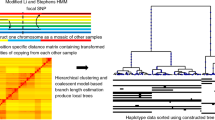Abstract
IT has been shown that inherited differences in human red cell acid phosphatase can be demonstrated by starch-gel electrophoresis1. So far, five distinct phenotypes (referred to as A, BA, B, CA and CB) have been identified, and family studies suggest that they are determined by three allelic genes (Pa, Pb and Pc). The relation between the observed phenotypes and the postulated genotypes is indicated in Table 1, and the frequencies with which the various phenotypes have been observed in a random sample of English adults are also given. The phenotype corresponding to the postulated genotype PcPc has not yet been identified. Theory suggests that this genotype would be rather uncommon (perhaps 1 in 600 of the population).
This is a preview of subscription content, access via your institution
Access options
Subscribe to this journal
Receive 51 print issues and online access
$199.00 per year
only $3.90 per issue
Buy this article
- Purchase on Springer Link
- Instant access to full article PDF
Prices may be subject to local taxes which are calculated during checkout
Similar content being viewed by others
References
Hopkinson, D. A., Spencer, N., and Harris, H., Nature, 199, 969 (1963).
Bessey, O. A., Lowry, O. H., and Brock, M. J., J. Biol. Chem., 164, 321 (1946).
Author information
Authors and Affiliations
Rights and permissions
About this article
Cite this article
SPENCER, N., HOPKINSON, D. & HARRIS, H. Quantitative Differences and Gene Dosage in the Human Red Cell Acid Phosphatase Polymorphism. Nature 201, 299–300 (1964). https://doi.org/10.1038/201299a0
Issue Date:
DOI: https://doi.org/10.1038/201299a0
This article is cited by
-
Multiallelic models of genetic effects and variance decomposition in non-equilibrium populations
Genetica (2011)
-
Association of acid phosphatase locus 1*C allele with the risk of cardiovascular events in rheumatoid arthritis patients
Arthritis Research & Therapy (2011)
-
Body mass index and acid phosphatase locus 1 in diabetic disorders
Acta Diabetologica (2010)
-
The genetics of feto-placental development: A study of acid phosphatase locus 1 and adenosine deaminase polymorphisms in a consecutive series of newborn infants
Reproductive Biology and Endocrinology (2008)
-
Phosphotyrosine protein phosphatase and diabetic pregnancy: an association between low molecular weight acid phosphatase and degree of glycemic control
Cellular and Molecular Life Sciences (1996)
Comments
By submitting a comment you agree to abide by our Terms and Community Guidelines. If you find something abusive or that does not comply with our terms or guidelines please flag it as inappropriate.



